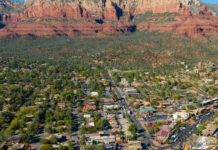The Sedona-Oak Creek Unified School District Educational Foundation announced on Jan. 27 that the organization has raised “over $10 million from numerous community members who deeply value education” and will be expanding its mission from providing scholarships to include support for school programs as well.
“Essentially it increases our annual budget by 4.2% of the endowment total,” SOCSD Superintendent Tom Swaninger Ph.D., said. “We are choosing to take that funding and support theatre, preschool” and the Wildcats Extended Day Program at West Sedona School.
Swaninger said the endowment is held by the Arizona Community Foundation and is anticipated to have a total annual return of 7%.
“A 4.2% return, that’s a lot of money, but if you figure that a teacher with benefits is, on average, roughly anywhere between $105,000 and $115,000 a year, it goes fast,” Swaninger said.
Unspent returns will be reinvested in the endowment and the foundation’s board is prevented “from authorizing any expenditure that would reduce the principal balance below 80% of its highest level at any time,” the organization’s announcement stated.
“In their commitment to fostering educational excellence, the board ultimately chose to establish two nonprofit funds: a board-designated [quasi-endowed] fund and a reserve [spendable] fund to support [SOCSD’s] mission,” ACF Regional Director Sheri Denny said.
The foundation’s board of directors includes President Randy Hawley, Vice President Basil Maher, Treasurer Joan Rumble Bouck, Secretary Mimi Maher and board members Bradford Andrews and Swaninger.
Swaninger said that he created a “wishlist” of programs and projects for SOCSD; Basil Maher said that to accomplish all of those goals would require an endowment of around $30 million.
“It’s a dream but it’s a really good dream, and hopefully we find enough people to help to help the dream out,” Maher said.
Maher said that the foundation’s goals for 2025 would include forming committees for public relations and fundraising.
“If you don’t have a good school system, affordable housing won’t mean anything, because people won’t come here because they can’t put their kids in the school system,” Basil Maher said.
Items on Swaninger’s wishlist include Spanish instruction for all students— it is unclear whether such education would be compulsory — and hiring an instructional technology specialist and a college and career specialist.
“Many of the additional programs and positions would likely focus on classroom support for our dedicated teachers,” Swaninger said. “These could include roles such as instructional coaches and aides at all levels, with a particular emphasis on primary grades where additional support is most critical.”
Swaninger said that restarting the district’s dormant theatre program has been a priority and that the new funding will enable the district to hire a theatre teacher as a staff position. The job listing for the position will likely be posted in February.
“If we have somebody that is unwilling or unable to take a full-time position, but is very interested in starting with a camp or an after-school program, that might be half the route that we have to go,” Swaninger said. “We do want to have a full-time position, though.”
“It’s critical that this would be able to connect with our student body, because there are students that already see themselves as being theatrical,” Swaninger said. “We’re hoping to bring some ofthose students that typically wouldn’t be a part of theatre.”
On July 9, the SOCSD Governing Board voted to reinstate preschool tuition of $450 per month, or $250 for low-income students.
“The foundation has stepped in to cover the remaining costs, with a long-term vision of fully funding preschool education,” the foundation stated in its announcement. The existing fee structure for preschool will remain in place and SOCSD will not be returning to free preschool because it did not increase district enrollment as had been hoped.
The foundation’s website states that the endowment might also be used to fund a revived football program, which Swaninger previously estimated would cost between $30,000 and $50,000 up front, excluding annual expenses. He said that 42 students have expressed interest in the program and SOCSD, which is classified as 2A by the Arizona Interscholastic Association, recently won an appeal to be able to play as a 1A school, which would allow it to field smaller eight-man teams but would also require more travel time.
Swaninger said that he expected the district board to vote on approving the return of the program in mid-February, although district staff posted a job opening for a football coach on Dec. 10 and have already held an information session for prospective players.
Hawley said that he was proud of the work of the foundation since it was formed in 2018 but was excited for its expansion.
“There’s a lot of kids who went on to postsecondary training that would not have been able to if they didn’t have the scholarships,”Hawley said. “However, we became a one-issue focus … it turned out that Jennette Bill and I were the only two people left from the original board. Then when we hired Swaninger we decided we would like to restructure the foundation.”
Bill stepped down from the board at the start of the year.
“I kept staying on, because we didn’t have very many board members. But now that it’s been rejuvenated, it has more board members, and it seemed like the right time to do that,” Bill said. “There’s a greatboard now and they’re motivated. They are looking for more people to contribute to this vision and make this an even bigger opportunity.”
For more information, visit socusdfoundation.org
